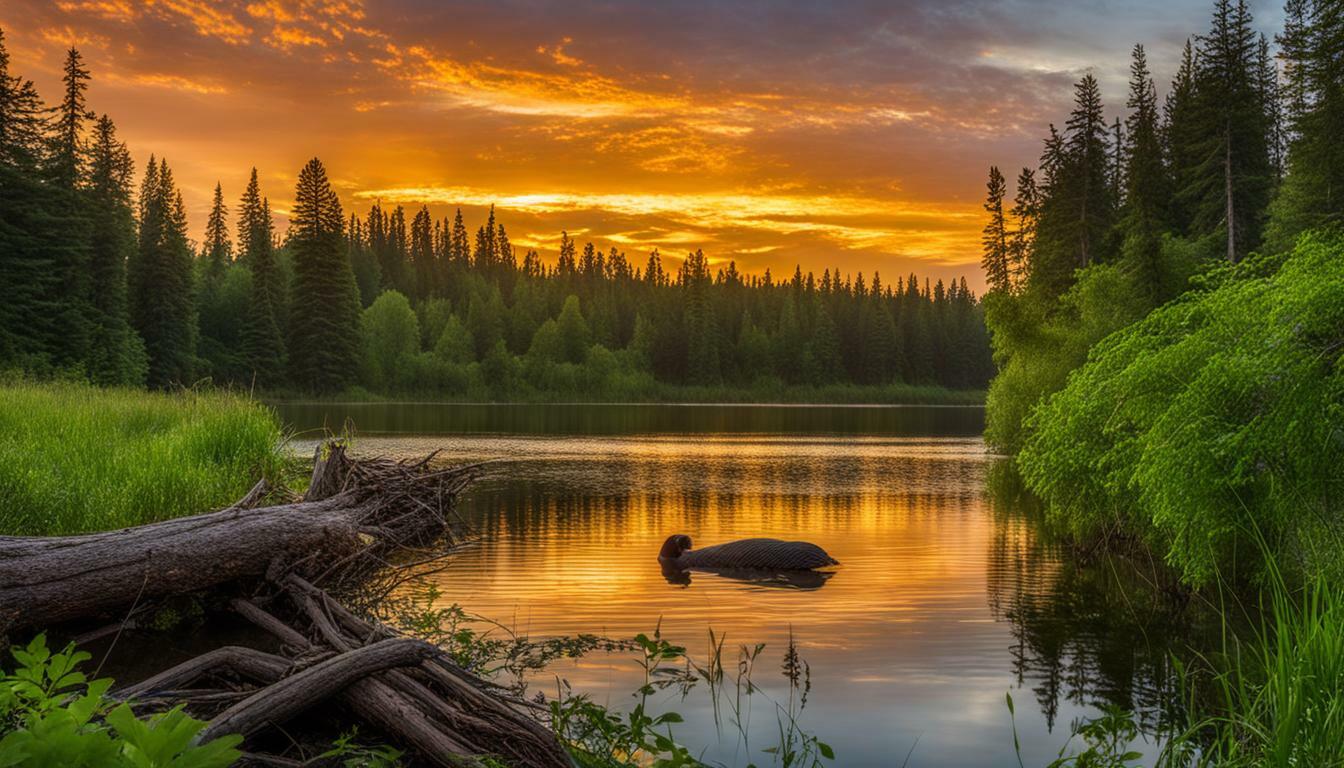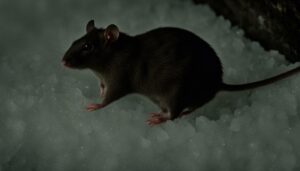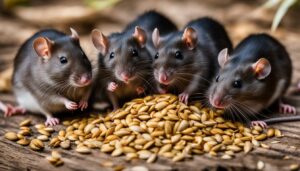Michigan is home to a thriving beaver population, with these fascinating creatures making a remarkable comeback in recent years. Beavers play a crucial role in the state’s ecosystems, but their numbers had declined due to trapping and habitat loss. However, there is good news as more beavers have been spotted in southeast Michigan along the Detroit and Rouge Rivers, indicating a resurgence in their population.
Key Takeaways:
- Beavers have made a comeback in Michigan, specifically in southeast Michigan along the Detroit and Rouge Rivers.
- The decline in beaver populations was caused by trapping for the fur trade and habitat loss due to industrialization.
- The recovery of beavers in Michigan is attributed to suitable habitats with access to water and food sources.
- The current beaver population is slowly increasing, with 325 sightings per year in 2020.
- Despite being beneficial for ecosystems, beavers are classified as nuisance wildlife in urban and industrialized areas.
Michigan’s Beaver Population Decline
The beaver population in Michigan experienced a significant decline due to habitat loss caused by industrialization and extensive trapping for their valuable fur. These factors led to a decline in suitable beaver habitats, as well as a decrease in the overall beaver population across the state.
Industrialization and urban development resulted in the destruction and fragmentation of beaver habitats, limiting their access to suitable water sources and food. As their habitats disappeared, beavers struggled to find suitable places to build their dams and lodges, impacting their ability to survive and reproduce.
In addition to habitat loss, beavers were heavily trapped for their fur, especially during the peak of the fur trade. This further contributed to the decline in their population, as trapping reduced their numbers and disrupted their social structure.
| Factor | Impact |
|---|---|
| Habitat Loss | Limited access to water and food sources |
| Trapping for Fur | Reduced population and disrupted social structure |
However, efforts have been made to conserve beaver populations and restore their habitats in Michigan. Conservation organizations and the Department of Natural Resources have implemented measures to protect and restore beaver habitats, including the creation of beaver management plans, the establishment of beaver-friendly policies, and the promotion of sustainable trapping practices.
In the next sections, we will explore the resurgence of beavers in Michigan and their important role in the state’s ecosystems.
The Return of Beavers in Michigan
In recent years, there has been an encouraging resurgence of beavers in Michigan, particularly in southeast areas along the Detroit and Rouge Rivers. These areas provide suitable habitats with access to water and food sources year-round, making them ideal for beaver populations. After facing a decline due to trapping for the fur trade and habitat loss caused by industrialization, the increasing sightings of beavers signify a positive recovery in their population.
The current beaver population in the region is estimated to be slowly increasing, reaching 325 sightings per year in 2020. This is a significant improvement compared to previous years, and it reflects the efforts in beaver conservation in Michigan. The return of beavers is seen as one of the most dramatic ecological recovery stories in North America, highlighting the resilience of these fascinating creatures.
While beavers play a beneficial role in ecosystems, their presence can sometimes cause challenges in urban and industrialized areas. Due to their activities, such as dam building and tree felling, the Department of Natural Resources has classified beavers as nuisance wildlife in these settings. However, the resurgence of beavers in Michigan also reflects positive changes in the region, such as improvements in pollution levels, the overall environment, and climate.
Overall, the return of beavers in Michigan is a positive sign of ecological recovery and the importance of wildlife conservation efforts. As more beavers continue to thrive in their natural habitats, it is crucial to strike a balance between their presence and the needs of urban and industrial areas. By doing so, we can ensure the coexistence of these remarkable animals and the preservation of Michigan’s diverse ecosystems for future generations to enjoy.
The Current Beaver Population
The current beaver population in Michigan is gradually increasing, with an estimated 325 sightings per year in 2020, marking a positive trend in their recovery. This resurgence of beavers in Michigan’s ecosystems is seen as one of the most dramatic ecological recovery stories in North America.
Beavers, once on the decline due to trapping for the fur trade and habitat loss caused by industrialization, are now making a comeback in Michigan. Their return is primarily observed in southeast Michigan along the Detroit and Rouge Rivers. These areas provide suitable habitats with ample access to water and food sources year-round, creating ideal conditions for beaver populations to thrive. The increasing number of sightings indicates a recovery in their population and a positive response to conservation efforts.
While beavers play a crucial role in maintaining healthy ecosystems by promoting water conservation, biodiversity, and habitat creation, their presence can be challenging in urban and industrialized areas. As a result, the Michigan Department of Natural Resources categorizes them as nuisance wildlife. However, the return of beavers to the region reflects significant improvements in pollution levels, the overall environment, and climate. These factors have contributed to the resurgence of beavers, showcasing the resilience of nature and the positive impact of conservation efforts in the region.
| Year | Number of Sightings |
|---|---|
| 2018 | 260 |
| 2019 | 285 |
| 2020 | 325 |
The table above illustrates the upward trend in beaver sightings in Michigan, providing tangible evidence of their population recovery. These numbers signify a positive outcome for wildlife conservation and highlight the importance of balancing the presence of beavers with the needs of urban and industrial development.
Beavers as Nuisance Wildlife
While beavers play a vital role in ecosystems, their presence in urban and industrialized areas of Michigan can lead to challenges, prompting the Department of Natural Resources to categorize them as nuisance wildlife. These industrious creatures, known for their ability to build dams and create wetland habitats, can often come into conflict with human infrastructure and activities.
One of the main challenges posed by beavers in urban areas is their dam-building behavior. By constructing dams on streams and culverts, they can disrupt the natural flow of water, leading to flooding and damage to roads, agricultural fields, and private property. Additionally, the felling of trees for food and building materials can cause damage to landscaped areas, gardens, and other vegetation in residential neighborhoods.
To address these issues, the Department of Natural Resources implements strategies to mitigate the impact of beavers in urban and industrialized areas. These strategies include the installation of flow devices that regulate water levels and prevent dam building, as well as the use of fences and tree wraps to protect valuable vegetation. By managing nuisance beaver populations, the department aims to strike a balance between the benefits beavers provide to ecosystems and the need to protect human infrastructure and property.
| Challenges Caused by Beavers in Urban Areas: | Management Strategies by the Department of Natural Resources: |
|---|---|
|
|
Summary
While beavers are important for maintaining healthy ecosystems in Michigan, their presence in urban and industrialized areas can lead to challenges. The Department of Natural Resources categorizes beavers as nuisance wildlife due to the potential impact they have on infrastructure and property. To mitigate these challenges, the department implements strategies such as flow devices, fences, and population management. By finding a balance between the benefits beavers offer to ecosystems and the need for human protection, Michigan aims to coexist with these industrious creatures.
Factors Contributing to the Beaver Resurgence
The return of beavers in significant numbers to Michigan is seen as one of the most remarkable ecological recovery stories in North America, attributed to improvements in pollution, the environment, and climate. These factors have created a more suitable habitat for beavers, allowing them to thrive and expand their populations.
One of the key factors contributing to the resurgence of beavers in Michigan is the reduction in pollution levels. Over the years, efforts have been made to reduce industrial pollution and improve water quality, creating a healthier environment for beavers to live in. Cleaner water not only supports the growth of aquatic plants and trees, which are essential food sources for beavers, but also provides better conditions for beaver lodges and dams to be built.
The overall environmental improvements in Michigan have also played a significant role in the beaver resurgence. Conservation efforts, such as the restoration of wetlands and the protection of natural habitats, have provided beavers with more opportunities to establish themselves in suitable areas. This has allowed them to find suitable food sources and build their characteristic dams, which provide important ecological benefits.
| Factors | Contributions |
|---|---|
| Pollution Reduction | Improved water quality and healthier environment |
| Environmental Improvements | Restoration of wetlands and protection of natural habitats |
| Climate Conditions | Suitable weather patterns and temperature ranges |
Furthermore, climate conditions have also played a significant role in the beaver resurgence. Michigan’s climate features suitable weather patterns and temperature ranges, allowing beavers to survive and thrive. This favorable climate provides beavers with longer periods of time to gather food before winter and ensures that their habitats remain intact throughout the year.
In conclusion, the resurgence of beavers in Michigan is a testament to the positive impact of pollution reduction, improved environmental conditions, and favorable climate. These factors have created an environment where beavers can flourish once again, leading to significant ecological recovery in the region. However, it is important to balance the benefits of beavers in ecosystems with the challenges they pose in urban and industrial areas, ensuring a harmonious coexistence between humans and wildlife.
The Impact of Beaver Recovery
The recovery of beavers in Michigan has had a profound impact on local ecosystems, highlighting the significance of wildlife conservation in the state. These industrious creatures, known for their ability to build dams and create wetland habitats, play a crucial role in maintaining the ecological balance.
Beavers are ecosystem engineers, transforming their surroundings to suit their needs. By constructing dams, they create ponds that provide a variety of benefits. These water bodies serve as habitats for fish, amphibians, and waterfowl, promoting biodiversity in the area. Additionally, the dams help regulate water flow, reducing the risk of flooding during heavy rainfall and ensuring a steady water supply during dry periods.
Table 1: Benefits of Beaver Activity in Ecosystems
| Benefits | Explanation |
|---|---|
| Enhanced Biodiversity | The creation of ponds and wetlands provides habitats for various species. |
| Water Regulation | Beaver dams help control water flow, reducing the risk of flooding and ensuring a consistent water supply. |
| Habitat Creation | Their dams create diverse habitats that support a wide range of plants and animals. |
| Water Filtration | The wetlands formed by beaver activity act as natural filters, improving water quality. |
Despite their positive impact, beavers can also be a source of concern in urban and industrialized areas. Their dam-building activities may lead to flooding and damage infrastructure. As a result, the Department of Natural Resources classifies beavers as nuisance wildlife in these settings and implements strategies to manage their populations while still valuing their ecological contributions.
The resurgence of beavers in Michigan is a testament to the success of wildlife conservation efforts and the restoration of favorable environmental conditions. This remarkable recovery story serves as a reminder of the importance of protecting and preserving our natural habitats, ensuring a harmonious coexistence between humans and wildlife.
Exploring Beaver Habitats in Michigan
Michigan offers a diverse range of habitats that support beaver populations, from riparian zones to wetlands, showcasing the adaptability and ecological importance of these fascinating creatures. Beavers are well-known for their ability to construct dams and create ponds, which provide them with the ideal conditions for building their lodges and raising their young.
In riparian zones, which are areas adjacent to rivers and streams, beavers play a crucial role in maintaining the health and balance of the ecosystem. Their dams help to regulate water flow, reducing erosion and sedimentation while also creating rich wetland habitats. These wetlands, in turn, provide a haven for a variety of wildlife species, including birds, fish, and amphibians, contributing to the overall biodiversity of the region.
Wetlands, such as marshes and swamps, are another important habitat for beavers in Michigan. These areas are characterized by their permanently saturated soils and are often densely vegetated. Beavers thrive in wetlands due to the abundance of food sources, such as aquatic plants and tree bark. Their foraging activities also have a significant impact on the vegetation, leading to a mosaic landscape of young and mature trees as a result of the beavers’ tree-cutting behavior.
| Habitat Type | Characteristics |
|---|---|
| Riparian Zones | Adjacent to rivers and streams, beavers create dams and ponds that regulate water flow, reducing erosion and creating wetland habitats. |
| Wetlands | Permanently saturated soils, densely vegetated, abundant food sources for beavers, and significant impact on vegetation through tree-cutting behavior. |
These different habitats not only provide a home for beavers but also have a broader impact on the overall ecology of Michigan. By creating wetlands and altering watercourses, beavers contribute to the purification of water, the prevention of flooding, and the rejuvenation of streams. They are key players in shaping and maintaining the balance of the natural environment, making their presence vital for the well-being of many other wildlife species that depend on these habitats.
The Role of Beavers in Ecosystems
Beavers serve as ecosystem engineers, their activities benefiting the environment by creating wetlands, promoting biodiversity, and contributing to water conservation in Michigan. These remarkable creatures play a crucial role in shaping the landscape and fostering a healthy ecosystem.
One of the primary ways beavers influence their surroundings is through their construction of dams. By building dams across streams and rivers, they create wetlands, which serve as valuable habitats for a diverse range of plant and animal species. Wetlands provide nesting sites for waterfowl, breeding grounds for fish, and food sources for various organisms.
Additionally, beaver dams help regulate water levels and control floods by slowing down the flow of water. This water conservation function is especially vital in the often unpredictable climate of Michigan. The dams act as natural reservoirs, storing water during periods of high rainfall and releasing it gradually during drier times, ensuring a more sustainable water supply for surrounding vegetation and wildlife.
| Benefits of Beavers in Ecosystems: |
|---|
| Wetland Creation: Beavers construct dams that create wetlands, supporting a diverse range of species. |
| Biodiversity Promotion: Wetlands created by beavers provide habitats for various plant and animal species. |
| Water Conservation: Beaver dams act as natural reservoirs, regulating water levels and ensuring a sustainable water supply. |
The importance of beavers in Michigan’s ecosystems cannot be overstated. Their presence has the potential to restore degraded habitats, foster biodiversity, and contribute to the overall health of the environment. However, it is crucial to find a balance between the benefits they provide and the challenges they may pose in urban and industrial areas, where their activities can disrupt human infrastructure. Understanding and managing this delicate equilibrium is essential for both wildlife conservation and human coexistence with these remarkable animals.
Conclusion
The resurgence of beavers in Michigan is not only a testament to the state’s ecological recovery but also a reminder of the delicate balance between wildlife conservation and human development.
Beavers, once on the decline due to trapping and habitat loss, have been making a comeback in southeast Michigan along the Detroit and Rouge Rivers. This recovery can be attributed to the availability of suitable habitats with ample access to water and food sources.
The current beaver population in the region is slowly increasing, with approximately 325 sightings per year in 2020. While beavers play a crucial ecological role, their presence in urban and industrialized areas can cause challenges, leading to their categorization as nuisance wildlife by the Department of Natural Resources.
However, the resurgence of beavers in Michigan indicates positive changes in pollution levels, the environment, and the climate, making it one of the most remarkable ecological recovery stories in North America. It serves as a reminder of the importance of protecting and balancing the needs of wildlife and human development to ensure a sustainable future for both.
FAQ
Are beavers making a comeback in Michigan?
Yes, beavers have been making a comeback in Michigan, particularly in southeast Michigan along the Detroit and Rouge Rivers.
Why did the beaver population decline in Michigan?
The decline in the beaver population in Michigan was mainly due to trapping for the fur trade and habitat loss caused by industrialization.
Why are beavers returning to Michigan?
Beavers are returning to Michigan because the area provides suitable habitats with access to water and year-round food sources.
What is the current beaver population in Michigan?
The current beaver population in Michigan is estimated to be slowly increasing, with 325 sightings per year in 2020.
Are beavers considered nuisance wildlife in Michigan?
Yes, beavers are categorized as nuisance wildlife in urban and industrialized areas of Michigan due to the challenges they can pose.
What factors have contributed to the resurgence of beavers in Michigan?
The resurgence of beavers in Michigan can be attributed to improvements in pollution levels, the environment, and the climate in the region.
What is the impact of beaver recovery on Michigan’s ecosystems?
The recovery of beavers in Michigan has positive ecological impacts, including water conservation, biodiversity, and habitat creation.
What are the different beaver habitats found in Michigan?
Michigan is home to various beaver habitats, including rivers, streams, ponds, and wetlands.
What role do beavers play in ecosystems?
Beavers play an important role in Michigan’s ecosystems by creating and maintaining wetlands, which serve as habitats for a wide array of wildlife and contribute to water regulation.




